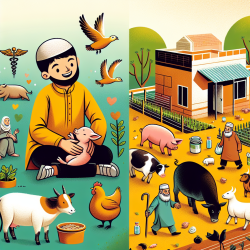Introduction
The relationship between livestock ownership and child health is a subject of growing interest, particularly in the context of developing countries. A recent study titled "Associations between livestock ownership and lower odds of anaemia among children 6–59 months old are not mediated by animal-source food consumption in Ghana" provides compelling insights into how owning livestock can influence child anaemia rates. This blog will delve into the study's findings and discuss how practitioners, especially those in the field of speech language pathology, can leverage these insights to improve child health outcomes.
Understanding the Study
The study conducted in Greater Accra, Ghana, examined 470 children aged 6–59 months. It aimed to assess whether household livestock ownership was associated with lower odds of anaemia in children and whether this relationship was mediated by the consumption of animal-source foods (ASFs) or by child morbidity and inflammation. The findings revealed that children from households owning a diverse range of livestock, including cattle, small livestock, and poultry, had significantly lower odds of anaemia compared to those from households with no livestock.
Key Findings
- Children from households with diverse livestock ownership had a 68% lower chance of being anaemic.
- The consumption of ASFs such as chicken meat and cow's milk did not mediate the relationship between livestock ownership and anaemia.
- No significant associations were found between livestock ownership and symptoms of illness or inflammation in children.
Implications for Practitioners
For practitioners in speech language pathology and related fields, these findings highlight the importance of considering broader socio-economic and environmental factors in child health. Here are some actionable insights:
- Holistic Assessment: When assessing a child's health and developmental outcomes, consider the family's socio-economic background, including livestock ownership.
- Community Engagement: Engage with communities to understand local practices and resources that may influence child health, such as livestock ownership.
- Advocacy and Education: Educate families about the potential health benefits of livestock ownership and advocate for policies that support sustainable livestock practices.
Encouraging Further Research
The study opens avenues for further research into how livestock ownership can be leveraged to improve child health outcomes. Future studies could explore:
- The specific mechanisms through which livestock ownership reduces anaemia risk, beyond ASF consumption.
- The role of livestock diversity in enhancing household nutrition and income, and its subsequent impact on child health.
- The potential benefits of integrating livestock ownership with other health and nutrition interventions.
Conclusion
Understanding the complex interplay between livestock ownership and child health can inform better practices and policies. As practitioners, integrating these insights into your work can contribute to more effective interventions and improved outcomes for children. For those interested in delving deeper into the study, I encourage you to read the original research paper.
To read the original research paper, please follow this link: Associations between livestock ownership and lower odds of anaemia among children 6–59 months old are not mediated by animal-source food consumption in Ghana.










